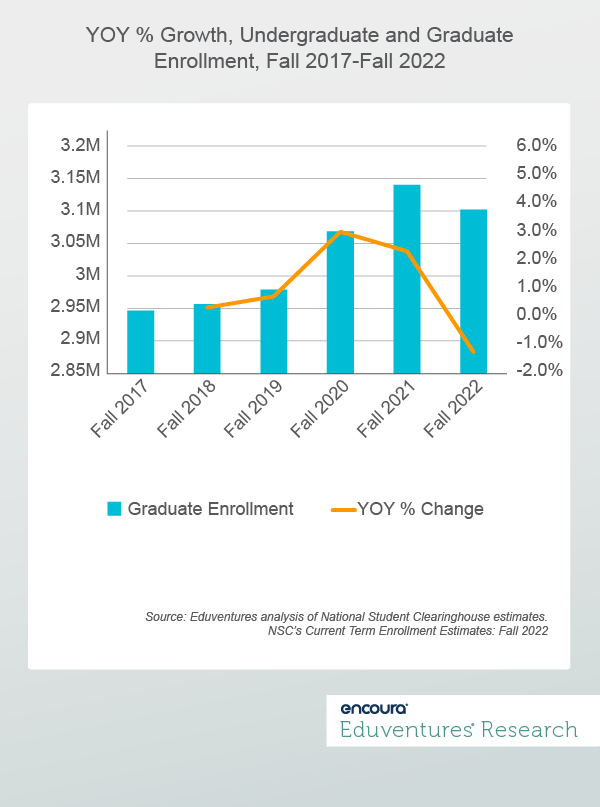June 14-16, 2023
Boston, MA
Over the past few years, Eduventures has pointed to several developing tensions in the graduate market, including a falling graduate enrollment rate and a program supply far outpacing demand. These tensions, however, were always offset by the fact that graduate enrollment, in absolute terms, continued to go up—in stark contrast to undergraduate enrollment over the last decade.
The National Student Clearinghouse’s (NSC) fall 2022 enrollment report indicates that Fall 2022 saw the first graduate enrollment decline in over a decade.
Looking Back
The graduate market has long been a boon for schools seeking to offset shrinking undergraduate enrollments. Based on NCES IPEDS data, graduate enrollment grew by 6% between 2010 and 2020, compared to a 14% decline at the undergraduate level—trends that continued through the pandemic.
In fall 2022, however, NSC reported a graduate enrollment decline of 1.2% just as undergraduate enrollment flattened out with only a slight decline of 0.6%. Figure 1 shows this drop, along with overall NSC graduate enrollment estimates from Fall 2017 to Fall 2022.

Arguably, the graduate market should be humming along. There are more 25–44-year-olds with a bachelor’s degree today than ever before (24.3 million in 2022, up an incredible 27% from 2010 according to the American Community Survey) suggesting the key prospect pool has never been larger.
Yet, we can point to several factors to explain this decline. Despite attention-grabbing headlines of mass layoffs, Fall 2022 unemployment rates remained at record lows in many states. Job openings remain high, too. When paired with low unemployment, this signals a labor shortage—perhaps a sign that a graduate credential may not carry as much weight in certain fields.
Additionally, Eduventures’ Adult Prospect Research™ continues to show a decline in both master’s and doctoral degree interest, each respectively seeing a 12% and 4% decline from July 2019 to October 2022. Interest in non-degree programming like certificates and individual courses remains above pre-pandemic interest levels.
Digging into the Details
While overall graduate enrollment stumbled in Fall 2022, what about specific fields of study?
NSC estimates indicate that 16 of 35 broad fields of study reported long-term graduate enrollment growth from 2017 and 2022. When also layering in fall 2021 to fall 2022 growth, this group shrinks to just seven when isolating markets that also saw enrollment grow in fall 2022 (Figure 2).
Graduate Markets Reporting Both Long-Term and YOY Growth
| Field | Fall 2022 | Fall 2017-Fall 2022 % | YOY % |
|---|---|---|---|
| Computer and Information Sciences and Support Services | 193,711 | 74.10% | 18.40% |
| Engineering | 176,557 | 5.70% | 4.60% |
| Psychology | 148,806 | 20.30% | 0.10% |
| Biological and Biomedical Sciences | 103,322 | 17.30% | 2.60% |
| Multi/Interdisciplinary Studies | 59,260 | 80.70% | 30.80% |
| Engineering Technologies/Technicians | 20,631 | 25.70% | 14.30% |
| Military Technologies | 2,552 | 126.70% | 4.20% |
Figure 2.
The computer sciences, engineering, psychology, and biological/biomedical sciences are the largest fields (over 100,000 enrolled) seeing sustained growth over the examined periods. These fields make sense given their STEM alignment and typically leading to occupations that either require graduate education or see above-average workforce attainment of graduate credentials despite no requirement. For example, 24% of engineers and about 20% of computer/information science-aligned workers have a master’s degree compared to the 10.6% workforce average.
Multi/Interdisciplinary studies also made this shortlist. The ability for students to create unique courses of study in these programs makes it a challenge to understand what exactly is driving growth, however, the flexible outcomes these programs provide may very well be a contributing factor. Additionally, the National Center for Education Statistics released new CIP codes for Data Science and Data Analytics in 2020 that fall under the broader multi/interdisciplinary studies umbrella.
Among the other nine fields of study that experienced long-term growth from 2017-2022, but year-over-year decline in 2022 (not shown here), we see some in which a graduate credential is a necessity, like health and law. In previous posts, we speculated that the early pandemic health market explosion was likely to come back to earth, and it looks like it has. Medical schools, for example, saw an 18% increase in applications for the 2021-2022 school year, but those numbers slipped back to pre-pandemic numbers in the most recent term.
The Bottom Line
Whether a blip or the start of a longer-term trend, fall 2022 brought us the first graduate enrollment decline in over a decade. If graduate enrollment growth is no longer a guarantee, other market tensions—like increased program competition and proliferating non-degree programs—become much more acute challenges.
Later this spring, Eduventures will publish the 2023 Master’s Market Update Report, which will provide more detailed analysis on these trends.
Never Miss Your Wake-Up Call
Learn more about our team of expert research analysts here.
Eduventures Senior Analyst at Encoura
Contact
Adult learners are anything but monolithic. A complex web of economic conditions, demographics, prior educational experiences, and the demands of family and work shape students’ perceptions and attitudes toward school.

